The hardest part of building a portfolio is having no client work to show.
I’ll show you the solution in just a bit…
The Meta Portfolio Experience (no, not the company)
This entire guide is structured as a copywriting portfolio piece.
As you read… notice how I organize information, emphasize benefits, and guide you toward action. These are the same techniques you’ll use in your own portfolio.
Know these:
- you don’t need years of experience to create a compelling portfolio
- you just need the right approach, focusing on what clients actually care about
Step 1: The 1-Hour Foundation
Before diving into creating samples, you need a basic structure to hold your work. Forget perfectionism. We’re aiming for a minimum viable portfolio that you can improve later.
Here’s what you need to get started:
The 5-Piece Bare-Bones Portfolio
- Something to “contain” your work
- An “About Me” section (under 100 words)
- A services list (what you can do for clients)
- 3-5 writing samples (we’ll create these in Step 2)
- Contact information
That’s it. Everything else is optional.
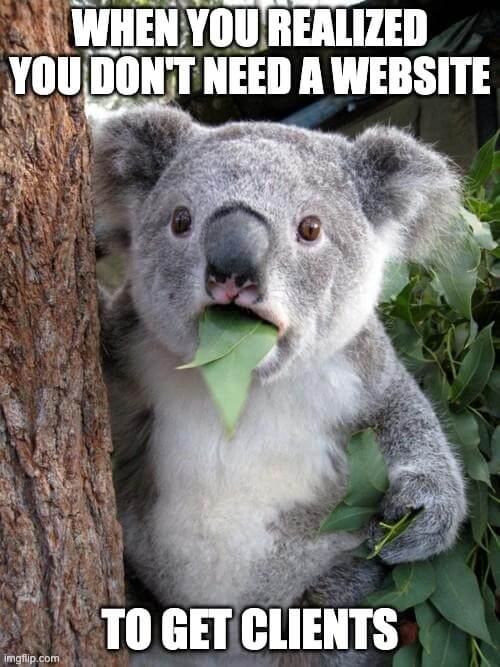
Many copywriters spend too much time perfecting their website before creating any samples. Start with the basics instead. Your “About Me” section doesn’t need to be fancy.
Template:
I help [target clients] achieve [specific outcome] through [your service]. With [results/experience], I focus on [your unique approach].
Examples:
Results: I help small business owners get more leads through website copy that actually explains what they do. After helping 5 local businesses collectively grow their revenue by $1.7 million in 3 years, I focus on clear, jargon-free language that connects with everyday customers.
Experience: I help fitness coaches fill their training programs through engaging social media content and landing pages. With a background in personal training and 5 years of writing experience, I focus on copy that speaks to real people’s health goals and motivations.
–
For your services list, stick to what you can confidently deliver. Even if you’re new, you can offer email writing, product descriptions, or social media copy based on skills you already have.
–
Choosing Your Portfolio “Home”
The platform you choose depends on your technical comfort level and time constraints.
Platform | Setup Time | Cost | Key Benefits |
|---|---|---|---|
30 minutes | Free | Easy to use, shareable, no tech needed | |
PDF Portfolio | 30 minutes | Free | Portable, printable, customizable |
Basic Website | 1-3 hours | $0-20/mo | Professional look, SEO benefits |
For beginners, I recommend Google Drive. Create a folder, add your samples as Google Docs, and share the link. Done. You can upgrade to a website later AFTER you have clients and income.
There’s absolutely no need to sign up for fancy portfolio platforms when you’re just starting out. Stick with the basics like Google Drive, simple PDFs, or free Canva templates. These tools are completely free and more than sufficient to land your first clients.
When setting up your Google Drive portfolio, create a main document that serves as your “homepage.” Include your bio, services, and links to each sample document. This creates a more professional experience.
For PDF portfolios, tools like Canva offer free templates designed specifically for copywriters. Search “copywriting portfolio” in their template section to find several professional options.
The Portfolio Purpose Worksheet
Take 15 minutes to answer these questions:
- What type of copywriting work do you want? (emails, ads, websites, etc.)
- Which industries interest you most?
- Who is your ideal client? (type of business, size of business, budget level)
- What problems can you solve for them?
Your answers will guide which samples to create.
This step saves you from the common mistake of creating random samples that don’t attract the right clients.
Be specific with your answers. Instead of “small businesses,” try “e-commerce stores selling sustainable products with $500K-$1M annual revenue.”
The more focused your portfolio, the more effective it will be. A jack-of-all-trades portfolio typically performs worse than a specialized one.
Meta Technique Spotlight
Notice how I’m breaking information into digestible chunks?
That’s the process simplification technique. When presenting your own work, use this same approach to make complex information easier to understand.
–
Step 2: Creating Your First 3 Portfolio Pieces
The hardest part of building a portfolio is having no client work to show.
But here’s a secret: clients also care about what you can do for them, not just where your samples came from.
The 90-Minute Spec Work
Spec work means creating samples for imaginary clients or improving existing content. It’s perfectly ethical when done properly.
Here’s how:
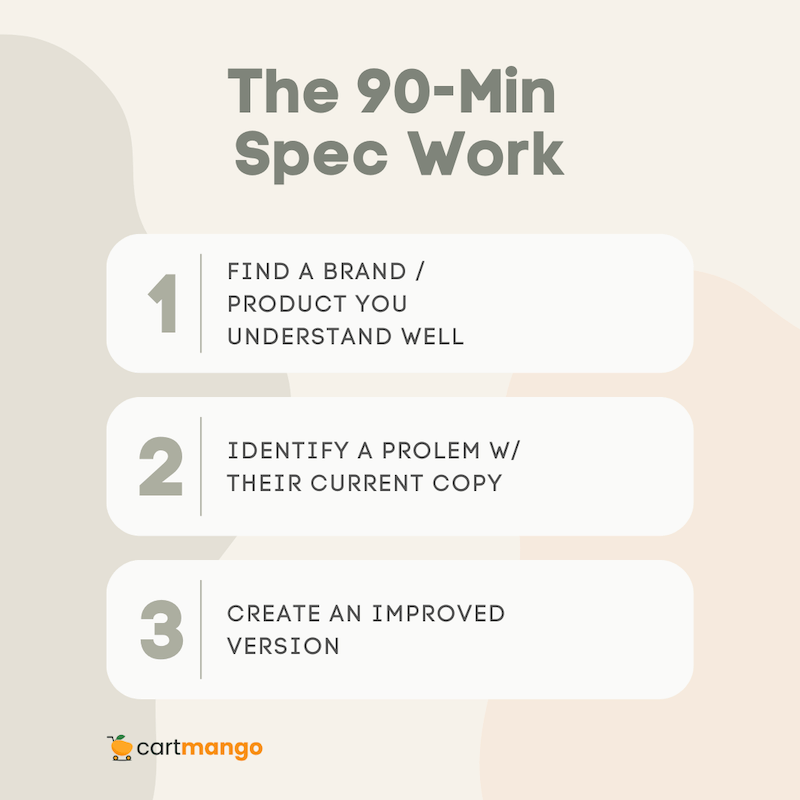
- Find a brand or product you understand well
- Identify a problem with their current copy
- Create an improved version
Don’t claim these as paid client work.
Instead, label them as “Sample Email Campaign for [Brand]” or “Proposed Improvements for [Brand] Website.”
Select brands you’re familiar with as a customer. Your insights will be more genuine and your copy more authentic when you understand the product personally.
When identifying problems with existing copy, focus on issues like:
- clarity
- benefit communication
- call-to-action strength
These are areas where improvements make obvious differences.
Save screenshots of the original copy before creating your improved version. This allows you to create before/after comparisons that demonstrate your impact.
Sample Prompts for Your Portfolio
Copy Type | Prompt Examples | Purpose/Use Case |
|---|---|---|
Email Sequences | Welcome series, abandoned cart | Nurture leads, recover sales |
Social Media Ads | Facebook ad, Instagram story copy | Engage audiences, promote offers |
Product Descriptions | Feature-benefit, comparison copy | Inform buyers, increase conversions |
Landing Pages | Hero headline, call-to-action copy | Capture leads, drive sign-ups |
Email Sequence Prompts:
Welcome Email Series
Create a 3-email welcome sequence for a subscription coffee service that introduces the brand, explains the subscription process, and encourages the first purchase with a 10% discount.
Write a sequence of two abandoned cart emails for an eco-friendly clothing brand. The first should be sent 2 hours after abandonment, the second 24 hours later. Focus on overcoming objections about price by emphasizing quality and sustainability.
Re-engagement Campaign
Develop a 2-email sequence for a fitness app targeting subscribers who haven’t opened the app in 30 days. Include personalization elements and a special offer to encourage them to return.
–
Social Media Ad Prompts:
Facebook Ad
Create a Facebook ad for a local bakery promoting their custom cake service for special occasions. Include headline, main text, and call-to-action that would appear in the Facebook feed.
Instagram Story Ad
Write copy for a 3-frame Instagram Story ad for noise-canceling headphones. Frame 1 should grab attention, Frame 2 should highlight key features, and Frame 3 should include a strong call-to-action.
LinkedIn Sponsored Post
Develop copy for a LinkedIn post promoting a free webinar on remote team management tools. Include headline, main text, and CTA button text.
–
Product Description Prompts:
E-commerce Product
Write a compelling product description for a multivitamin supplement that targets busy professionals. Include features, benefits, and reasons to purchase now.
SaaS Tool Description
Create a persuasive description for a social media scheduling tool that helps small businesses save time. Focus on the main problem it solves and include technical specifications.
Comparison Product Page
Develop copy for a ‘Which Plan Is Right For You?’ section comparing three tiers of a meal delivery service (basic, premium, family).
–
Landing Page Prompts:
Lead Generation Page
Write the hero section copy (headline, subheadline, and CTA) for a free ebook about home organization techniques.
Webinar Registration Page
Create copy for a landing page promoting a webinar on investment strategies for beginners. Include headline, bullet points of benefits, speaker bio, and registration button text.
Free Trial Sign-Up Page
Develop copy for a landing page promoting a 14-day free trial of a project management tool. Include headline, 3-5 key benefits, FAQ section, and sign-up button copy.
–
Pick 3 different types from this list to showcase your versatility. Don’t try to create samples for every category – that’s overwhelming and unnecessary.
I recommend creating at least one email sequence, as email marketing consistently delivers high ROI and is always in demand from clients.
Focus on one industry to establish expertise. Three varied samples for the fitness industry will position you better than three samples from different industries.
The Copy Renovation Technique
One of the easiest ways to create samples is by improving existing copy.
Here’s my 4-step process:
- Find weak copy on a website or email (look at small businesses)
- Save the original version
- Create your improved version
- Present both side-by-side with notes explaining your changes
This shows critical thinking and problem-solving skills, which clients value highly. You can use Canva’s before/after templates to create professional-looking comparisons quickly.
Look for websites with obvious copy problems like vague language, missing benefits, or weak calls to action. Local business websites often have these issues.
When explaining your changes, be specific about why they improve the copy.
❌ Made it more engaging
✅ Added specific cost savings ($350/month)
This makes the benefit concrete and compelling.
Meta Technique Spotlight
Did you notice the bullet hierarchies I’m using? This organization technique makes information scannable. Use this same approach when presenting your portfolio pieces to make them easier to digest.
–
Step 3: Building Real-World Samples
Spec work is a great start, but real-world samples add credibility. Here are three ways to get them without waiting for paying clients.
The Small Business Partnership Email Template
Local businesses often need better copy but can’t afford professional help. This creates an opportunity for you.
Here’s an email template that gets responses:
=== Template starts ===
Hi [Name],
I’m a copywriter focusing on [their industry]. I noticed [specific observation about their current copy] on your [website/email/etc.].
Would you be open to a free copy update for your [specific page/email]? In exchange, I’d like to include the work in my portfolio with your feedback.
Let me know if you’re interested, and I can share more details.
Thanks,
[Your Name]
=== Template ends ===
–
=== Example starts ===
Hi Tom,
I’m a copywriter focusing on home services. I noticed your Services page lists all your plumbing options but doesn’t mention the benefits or why someone should choose your company over competitors.
Would you be open to a free copy update for your Services page? In exchange, I’d like to include the work in my portfolio with your feedback.
Let me know if you’re interested, and I can share more details.
Thanks,
Michael
=== Example ends ===
Send this to 10 local businesses and you’ll likely get 2-3 positive responses. That’s enough to build your initial portfolio.
Tips
- When reaching out, be specific about what you noticed. “I saw your About page doesn’t highlight your 20 years of experience” is better than “Your website could use better copy.”
- Offer a small, defined project like rewriting one specific page or email. Many business owners will decline if the scope seems too large or undefined.
- If they accept, treat this like a professional project. Set clear deadlines, ask questions about their audience and goals, and deliver polished work.
- After completing the project, ask for a brief testimonial. Even a one-sentence comment about your professionalism or the quality of your work adds credibility to your portfolio.
Nonprofits That Need Copywriters
Nonprofits often need writing help and make great portfolio additions. They show your ability to write persuasively for a cause.
VolunteerMatch lists organizations looking for volunteer copywriters. You can filter by remote opportunities to find projects you can do from anywhere.
The process is simple:
- Search for writing opportunities
- Apply with a short message about your interest
- Complete a small project
Most need help with donation pages, newsletters, or social media content – all valuable portfolio pieces.
Organizations like the American Cancer Society, local animal shelters, and environmental groups frequently need volunteer copywriters. The higher profile the organization, the better your portfolio piece will look.
When working with nonprofits, focus on measurable results whenever possible.
“Helped increase donation page conversions by 14%” makes a much stronger portfolio entry than just “Wrote donation page copy.”
Set clear boundaries about the scope of work you’re offering. Some nonprofits might unintentionally ask for more than you can provide as a volunteer.
The 24-Hour Spec Project Planner
Sometimes you need samples quickly.
Here’s how to create a complete spec project in 1 day:
- Morning: Pick a brand and project type (website homepage, email sequence, etc.)
- Afternoon: Research and create first draft
- Evening: Edit, format, and add context
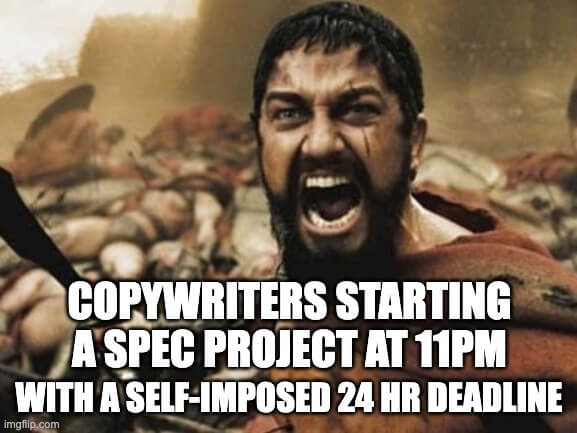
For morning research, spend 30 minutes on the brand’s website, 30 minutes checking competitors, and 30 minutes understanding the target audience. This foundation makes your copy much stronger.
Don’t overthink the first draft. Set a timer for 60-90 minutes and focus on getting your ideas down. You can refine everything during the evening editing session.
Adding context means creating a brief case study around your work.
Explain what problem you were solving, why you chose certain approaches, and what results could be expected.
Tips
- If creating a full campaign feels overwhelming, focus on a specific piece like a single email or one landing page. A well-executed small project beats a mediocre larger one.
- Portfolios with fewer, high-quality samples are more effective than those with many average examples.
Meta Technique Spotlight
Time-focused language creates urgency. Notice how I’m using timeframes? Apply this technique when describing your portfolio process to clients. It shows efficiency and professionalism.
–
Step 4: The 60-Minute Portfolio Assembly System
Now that you have samples, let’s put everything together in a way that impresses potential clients.
Organizing Your Samples for Max Impact
Your portfolio organization affects how clients perceive your work.
Organization Format | Pros | Cons |
|---|---|---|
Google Drive | Free, easy to use, shareable | Less professional looking |
PDF Portfolio | Free, portable, printable | Less interactive, static format |
Canva Template | Free, professional design, easy | Some customization limitations |
Regardless of format, organize each sample using the Problem-Solution-Result structure:
- What issue was the client facing?
- How did your copy address it?
- What results were achieved (or could be expected)?
This structure shows clients that you understand the strategic side of copywriting, not just the writing itself. That’s what separates professionals from amateurs.
For PDF portfolios, create a clickable table of contents so clients can jump directly to samples that interest them most. This small detail improves the user experience significantly.
If you’re using Google Drive, create a master document with links to each sample and a brief description. This creates a more professional, organized experience for clients reviewing your work.
Creating Portfolio Variations in Minutes
Different clients need different things. Create variations of your portfolio to target specific industries or projects.
The modular approach works best:
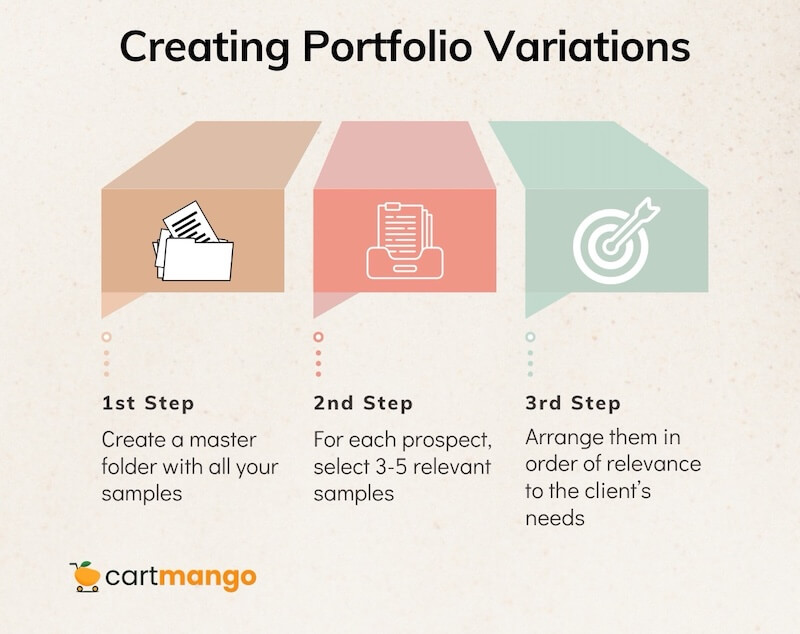
- Create a master folder with all your samples
- For each potential client, select 3-5 relevant samples
- Arrange them in order of relevance to that client’s needs
This takes just minutes but dramatically increases your chances of landing the job. Having multiple versions ready saves time when opportunities arise.
When applying for email copywriting jobs, lead with your email samples. For website projects, put your landing page samples first. This seems obvious, but many copywriters make the mistake of using a fixed order.
Create industry-specific versions too. Having “Tech Industry Portfolio” and “Health Industry Portfolio” versions ready saves time when opportunities arise.
Keep track of which portfolio variations perform best. If your healthcare-focused version gets more responses than your tech version, that’s valuable information about where to focus.
Portfolio Section Templates
Save time with these ready-to-use section templates:
For the About Me section:
I help [target clients] achieve [specific outcome] through strategic copywriting. With experience in [industries/formats], I focus on creating copy that [unique value proposition].
–
For the Services section:
My copywriting services include:
- [Service 1]: Perfect for businesses that need [specific outcome]
- [Service 2]: Designed to help you [benefit]
- [Service 3]: The solution when you’re struggling with [common problem]
–
For individual portfolio pieces:
“[Project Title]
Client: [Client name or ‘Spec project’]
Challenge: [What problem needed solving]
Approach: [How you tackled it]
Result: [Outcomes or expected outcomes]”
–
For displaying samples, use the Hemingway Editor to ensure your descriptions are clear and concise. Simplicity beats fancy language every time.
When writing project descriptions, focus on the business problem, not just the writing assignment. “Increased email click-through rates” is more compelling than “Wrote email copy.”
Keep these descriptions brief. Folks are impatient these days. They’ll only spend a few seconds on each portfolio piece before deciding whether to read more deeply.
Meta Technique Spotlight
Notice how I’m using “contextual storytelling” throughout this section – explaining not just what to do but why it matters. This technique creates a narrative flow that helps readers understand the purpose behind each action. When presenting your portfolio pieces to clients, use this same contextual approach to explain your process and decisions rather than just showing the final work.
–
Step 5: The Client’s-Eye View Simulation
Understanding how clients evaluate portfolios gives you a major advantage. Let’s peek inside their thought process.
What Actually Happens When Clients Review Portfolios
When a client opens your portfolio, they typically scan it for just 7-8 seconds before deciding whether to look closer. According to Nielsen Norman Group research, they follow an F-shaped pattern-reading the top thoroughly, then scanning down the left side.
This means your strongest piece should appear first, and each section should start with compelling information. Clients look for relevance to their industry, clarity of writing, and evidence that you understand their problems.
When clients first land on your portfolio, they’re asking themselves 3 questions:
- Can this person solve my problem?
- Have they worked with businesses like mine?
- Do they understand my industry?
Your portfolio needs to answer these questions immediately.
Decision-makers often review portfolios between meetings or during short breaks. This means they may be distracted or rushed, making clear organization and scannable content even more important.
Clients rarely read every word of your samples.
Instead, they focus on headlines, subheadings, and the first few sentences of each section to get a feel for your style and approach.
The Client’s Thought Process
Here’s what clients say to themselves when reviewing portfolios:
“I immediately closed the portfolio when I saw grammar errors in the first paragraph. If they can’t proof their own work, how can I trust them with mine?”
“What made me hire this writer was how they explained their thinking process behind each piece. I could see they understood strategy, not just writing.”
“I need someone who understands my industry. This portfolio showed relevant examples right away, so I didn’t have to dig.”
“Too many portfolios show random writing samples without context. I want to know why certain choices were made and what problems they solved.”
“I look for copywriters who can show the before and after. It helps me see the transformation they can create for my business.”
“When reviewing portfolios, I pay attention to how they organize information. If they can structure their own work clearly, they’ll likely do the same for my projects.”
The lesson?
Proofread meticulously, explain your process, and make relevant work instantly visible.
The Client Simulation Checklist
Put yourself in the client’s shoes with this 5-minute self-assessment:
- Can someone understand what you do in 5 seconds?
- Is it immediately clear which industries you serve?
- Do your samples address common client problems?
- Is your contact information easy to find?
- Does your portfolio pass the “so what” test? (Does it show benefits, not just features?)
- Is your unique approach or perspective evident?
- Would a busy professional find your portfolio easy to navigate?
- Does your portfolio avoid industry jargon that clients might not understand?
For objective feedback, you can use a tool like this to watch real people review your portfolio. Their reactions will show you exactly what’s working and what needs improvement.
Ask specific questions when getting feedback: “Where would you click first?”, “What type of business do you think I work with?”, “What services do I offer?” The answers reveal if your portfolio is communicating effectively.
Getting feedback from non-writers can be especially valuable. They’ll respond more like actual clients than other copywriters who might focus on craft details.
Meta Technique Spotlight
The insider knowledge positioning technique I’m using here works great in your portfolio too.
When you demonstrate understanding of client challenges, you position yourself as an expert, not just a writer.
–
(Optional) Expanding Your Portfolio to Showcase What You Can Really Do
So you’ve got your basic portfolio up and running. Great start!
Now might be a good time to think about expanding it a bit to show off more of your copywriting abilities. I’ve found that a more varied portfolio helps prospective clients and potential employers see the full range of your writing skills.
Mix Up Your Content Types (Because Clients Need Different Stuff)
The copywriting business isn’t just about writing one type of content anymore. You know what I mean? Here are some different formats worth adding:
Blog Posts and Articles
Most companies need regular blog posts as part of their content marketing strategy. Try including one or two sample posts that show you can explain complicated things simply. Doesn’t have to be anything fancy – just clean, helpful writing that keeps people reading.
Social Media Posts and Captions
Social media marketing is huge, obviously. Maybe add a page with some sample social media captions for different platforms. These short pieces are actually pretty challenging to write well. They show you can grab attention in just a few words, which is… well, it’s harder than it looks.
Sales Pages That Actually Sell
I believe sales pages are where persuasive language really matters. Include at least one example that shows how your compelling copy might convert readers. This is often what makes clients sit up and notice you.
Cover Letter Samples (Yeah, People Still Need These)
Some hiring managers want to see versatility. A brief introduction to how you approach cover letters shows you understand professional communication beyond just marketing stuff.
Make Your Portfolio Something People Actually Want to Look At
Your primary aim should be creating an online writing portfolio that doesn’t bore people to tears.
Show How Your Copy Solved Problems
For each piece, briefly mention what problem it addressed. Like, “This email sequence was designed to win back customers who hadn’t purchased in 6 months.” Just gives context, you know?
Show You Can Write in Different Voices
I’ve noticed creative writing flexibility is something clients really value. They want to know you can match their brand voice, not just write in your own style.
Easy Access Matters More Than You’d Think
Whether it’s a personal website or something simpler, make your portfolio easily accessible. Nothing frustrates potential clients more than having to jump through hoops to see your work.
For the Complete Beginners Out There
Starting a copywriting career with zero experience is tough.
Been there. Which is why your portfolio becomes even more important:
The Next Few Months Are Critical
Try to build your portfolio gradually over the next few months. Add one new piece every couple weeks. Rushing to create everything at once usually leads to… well, not great work.
Your Short Bio Doesn’t Need to Reveal Your Inexperience
Even without previous clients, your short bio can focus on your writing abilities and relevant interests. No need to apologize for being new – everyone starts somewhere.
A good copywriting portfolio helps open doors that would otherwise stay firmly shut. It’s a surprisingly powerful tool that works for you even when you’re sleeping or watching Netflix. Not bad for something you can create in a weekend, eh?
–
Step 6: Getting Quick Results From Your New Portfolio
Having a portfolio is just the beginning. Now you need to get it in front of potential clients.
The 5-Day Client Acquisition System
- Day 1: Identify 10 potential clients you’d like to work with
- Day 2: Research their current copy needs and pain points
- Day 3: Customize your portfolio for each (select relevant samples)
- Day 4: Send personalized outreach emails (template below)
- Day 5: Follow up with non-responders
This systematic approach works better than random applications. It focuses your efforts on clients who match your expertise.
When identifying potential clients, look for companies that are actively growing or changing. They typically have immediate copy needs for their new initiatives.
Research should include reviewing their website, social media, and any recent press releases or news. These sources often reveal current priorities and challenges.
Customization doesn’t mean creating new samples for each prospect. It simply means selecting the most relevant existing samples and arranging them in a logical order for that specific client.
Don’t skip the follow-up on Day 5.
According to HubSpot, 80% of successful deals require at least five follow-ups, yet most freelancers give up after just one or two attempts.
The Portfolio Intro Email Template
Here’s a template that gets responses:
=== Template starts ===
Subject: Question about [specific copy on their website/email]
Hi [Name],
I noticed [specific observation about their current copy] on your [website/email/etc.].
I’m a copywriter specializing in [relevant specialty], and I’ve helped businesses like [similar business] achieve [specific result].
Would you be open to a 15-minute chat about how I might help improve your [specific copy element]? I’ve included a few relevant samples from my portfolio [that achieved X result].
Thanks,
[Your Name]
=== Template ends ===
–
=== Example starts ===
Subject: Question about your homepage headline on ProjectPro.com
Hi Daniel,
I noticed your homepage headline “Project Management Software” doesn’t mention the main benefit your customers get from using ProjectPro – the 20% time savings you reference later on the page.
I’m a copywriter specializing in software companies, and I’ve helped businesses like TaskMaster and TeamFlow achieve higher conversion rates by making their main benefits clear in headlines.
Would you be open to a 15-minute chat about how I might help improve your homepage messaging? I’ve included a few relevant samples from my portfolio showing before-and-after headline changes that increased sign-ups by 22%.
Thanks,
Jennifer
=== Example ends ===
Keep your email under 150 words. Busy decision-makers appreciate brevity and are more likely to respond to concise messages.
Avoid attaching files that might get caught in spam filters. Instead, include a link to your online portfolio or offer to send samples upon request.
If you don’t hear back within 3-4 days, send a short follow-up:
“Checking if you received my previous email about your website copy and how it might improve your results?”
When you do get responses, reply within 24 hours to maintain momentum. Having your portfolio ready makes it easy to share relevant samples immediately.
Setting Up a Simple Portfolio Tracking System
Use a simple Google Sheet to track:
- Who you’ve contacted
- Their contact info
- When you sent your portfolio
- Their response
- Follow-up dates
- Notes from conversations
Here’s an example of what it could like like:
Company/Contact | Email Address | Date Sent | Portfolio Version | Response | Follow-up Date | Notes |
|---|---|---|---|---|---|---|
Green Earth Café Mary Johnson | mary@gec. com | 05/04/25 | Food & Beverage | No response | 05/08/25 | Local café with outdated menu descriptions. Mentioned their seasonal specials in email. |
TechSolutions Inc. David Lee | david.lee@ts. com | 05/03/25 | B2B Software | Interested – requested call | 05/10/25 | Call scheduled for 05/11. Liked email samples. Potentially needs help with customer onboarding sequence. |
Fitnesz First Sarah Wilson | s.wilson@ffz. com | 05/02/25 | Health & Wellness | Declined – no budget | N/A | Friendly response. Said to check back in 3 months when new programs launch. |
Tip:
- Color-code rows by status (interested, declined, no response)
- Include a “Results” column to document outcomes from successful contacts
This helps you identify which approaches are working best.
Include columns for “Portfolio Version Sent” and “Response Time” to track which variations perform best and how quickly prospects typically reply.
Review your tracking system monthly to identify patterns. You might discover that certain industries respond better than others or that specific portfolio pieces generate more interest.
Don’t just track positive responses. Note objections or concerns raised by prospects to identify areas for portfolio improvement.
This system also helps prevent awkward situations like contacting the same person twice or forgetting to follow up with an interested prospect.
Meta Technique Spotlight
Numbers and statistics add credibility to your claims.
Use this technique in your portfolio by including specific metrics whenever possible, even for spec work (e.g., “This email sequence could improve open rates by 15% based on industry averages”).
–
Step 7: The Weekend Portfolio Enhancement Plan
Once you’ve used your portfolio for a while, take a weekend to enhance it based on the feedback you’ve received.
Three One-Hour Updates That Improve Results
1/ Add social proof
Even without client testimonials, you can include feedback from peers, writing group members, or mentors. A simple quote like “Sarah’s attention to detail and clear writing style make her copy stand out” adds credibility.
2/ Create “The Process Behind This Project” sections
For each portfolio piece, add a short paragraph explaining your approach. Clients love seeing your thinking process almost as much as the final product.
3/ Make visual improvements
Improve your portfolio’s appearance. Simple changes like consistent fonts, proper spacing, and strategic use of bold text make a big difference.
–
These quick updates can lead to better results without requiring a complete overhaul.
For social proof, reach out to 3-5 people who are familiar with your writing and ask for specific feedback about your strengths. Brief, focused testimonials work better than generic praise.
When creating process sections, follow this structure:
- challenge identification
- research conducted
- strategic approach
- and writing considerations
Keep each less than 100 words.
Visual improvements don’t require design skills. Focus on consistency-using the same font, color scheme, and formatting throughout creates a professional impression.
Consider adding a simple case study format for your best samples. Include the client brief, your strategy, the final copy, and the results (or projected results for spec work).
The Client Perspective Review
After making improvements, review your portfolio again from the client’s perspective:
- Does it clearly communicate who you help and how?
- Is there a logical flow from one piece to the next?
- Do you address potential objections before they arise?
- Is your unique approach evident throughout?
Ask a friend or colleague to review it too. Fresh eyes often spot issues you’ve become blind to.
When reviewing your own work, try the “first impression test.” Open your portfolio and look away, then look back for just 5 seconds. What stands out? What message do you get? This mimics a client’s initial scan.
Check for inconsistencies in how you present your services or describe your experience. Mixed messages confuse potential clients and reduce trust.
Ensure your portfolio loads quickly and works well on mobile devices. Technical issues create a poor impression regardless of your copy quality.
Meta Technique Spotlight
Notice my problem-agitation-solution structure? I present a challenge, explain why it matters, then offer a solution. This persuasive technique works great in portfolio case studies too.
–
Next: Your 7-Day Portfolio Action Plan
Let’s put everything together into a simple 7-day plan:
Day | Task Description | Time Commitment | Expected Outcome |
|---|---|---|---|
1 | Portfolio assessment and goal setting | 30 minutes | Clear portfolio purpose and focus |
2 | Set up portfolio platform | 1 hour | Functional portfolio foundation |
3 | Create first 3 portfolio pieces | 90 minutes | Minimum viable portfolio samples |
4 | Build real-world samples | 1 day | Practical, client-ready samples |
5 | Assemble and organize portfolio | 1 hour | Polished, client-friendly portfolio |
6 | Client outreach and sharing | 5 days | Initial client leads and feedback |
7 | Portfolio review and enhancement | 1-2 hours | Improved portfolio and confidence |
This plan is designed to be manageable even if you’re working on your portfolio while holding down another job. The daily time commitments are realistic for busy people.
Day 1 is all about clarity-knowing exactly what you want your portfolio to achieve helps every decision that follows. Don’t skip this foundation step.
On Day 2, choose the simplest platform that meets your needs. Remember, just use Google Drive or a PDF – no need for paid platforms at this stage.
Day 3 focuses on creating your initial samples. If you get stuck, return to the prompts in Step 2 for inspiration.
Day 4 might seem intimidating, but remember that even one real-world sample is valuable. Focus on quality rather than quantity.
Day 5 is about organization and presentation. Even brilliant writing samples fail to impress when poorly organized.
Days 6-7 focus on getting your work seen and refining based on feedback. These are ongoing processes that continue beyond the initial week.
Before sharing your portfolio, check this quick list:
- No spelling or grammar errors (this is non-negotiable)
- Contact information is current and easy to find
- All links work properly
- Samples are relevant to your target clients
- Each piece includes context and background
Now it’s your turn. Start building your portfolio today. Your future clients are waiting.
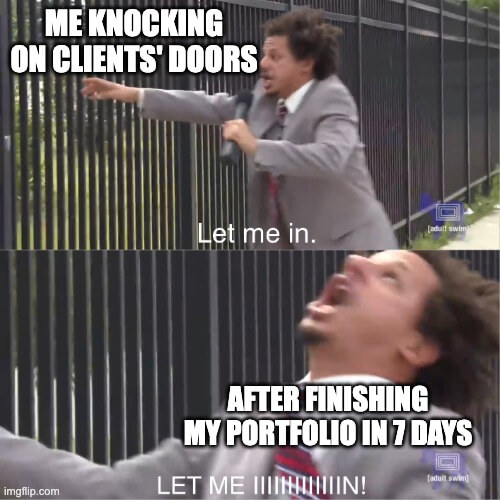
Related
- Gumroad vs Sellfy: The Vendor Lock-in Cage (2025)
- Gumroad vs Payhip: The Hidden Trap for Creators (2025)
- ThriveCart vs SamCart – The Subscription Hostage Trap (2025)
- 8 ThriveCart Alternatives & The Lifetime Pricing Paradox (2025)
- 8 SamCart alternatives + Subscription hostage (2025)
- The GENTLE Method: Soft marketing for creators
- How Far in Advance Should You Promote a Webinar?
- The SAVINGS Method: The Productivity Improvement Plan for Creators
- 9 Questions to Ask: How to Hire a Digital Marketing Agency
- Decision That Costs Millions? Marketing Funnel vs Customer Journey
